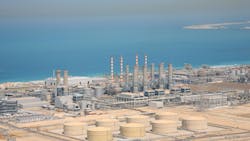How technology is helping to digitally optimize energy usage and life cycle costs in desalination
As the world’s population continues to increase, the pressure on water resources increases too, intensified by geography as well as climate change. The Middle East and North Africa region includes 17 countries below the Water Poverty Line, as set by the United Nations, and is considered the world’s most water-scarce region. As a result, there is a heavy reliance on desalination to produce water across the area. This process is energy intensive, with increased pressure on governments and utilities to minimize energy consumption and optimize water usage.
Desalination and Digitalization in Water
Desalination plants built to solve the world’s critical issue of usable water typically utilize a high energy-consuming process. In fact, energy usage can account for more than 20 percent of operational costs. Therefore, energy efficiency and life-cycle cost optimization are among the most important challenges for utilities and for developers within the context of the desalination plant.
Increasingly, more energy-efficient and cost-competitive desalination technologies to produce fresh water at optimal costs are becoming available. These include products and solutions covering the entire electrical and automation scope for desalination projects, with the clear goal of maximizing plant efficiency and productivity levels: drives and motors; soft-starters; low, medium, and high-voltage switchgear and components; transformers; instrumentation; control products and programmable logic controllers (PLCs); distributed control systems (DCS); and optimization tools.
With insights from real-time big data, operators can make informed decisions to drive efficiencies that enable operational excellence, ensure asset reliability and availability, mitigate risk, and ultimately enhance performance and productivity.Optimizing Energy Usage and Life Cycle Costs
Significant contributors to the cost of delivering clean, safe, and reliable water are the energy to move it and the chemicals required to treat it. The first steps toward optimizing energy consumption and costs focus on monitoring, documenting, analyzing, and understanding exactly how energy is currently consumed. There are several ways to optimize energy usage and life cycle costs. First, let’s look at the potential impact on capex.
Capital Expenditure, Design, and High-Performance Equipment
There is rightly much focus on reducing operating costs, but there is additional scope in the impact of optimizing the engineering design to initially reduce capex costs. The reduction of costs in this way can make a project viable. For example, a customer investing in electrical design can reduce overall capex by changing voltage levels and changing the size and number of transformers, with the result of 10–15 percent savings in capex cost reductions for the equipment. This translates to an approximate 3–5 percent reduction in overall project capex costs. With multi-million-dollar investments, this can represent significant savings.
The installation of high-performance equipment reduces energy consumption. Drives will reduce electrical losses from the benchmark target of 5 percent to only 3 percent — a huge improvement in energy efficiency compared to accepted industry standards. This is very important because, depending on the type of desalination process, energy consumption is between 15 and 20 percent of the total production cost. By improving efficiency, these costs can be lowered, making potable water more affordable and available to more people.
Variable speed drives can be used to control the motor speed of pumps with typical 30–60 percent savings in energy consumption. The use of drives also reduces mechanical and electrical stress on pumps and other components. In combination with high-efficiency motors, variable speed drives not only make water processes in all parts of the water cycle more efficient but also help reduce maintenance costs.
Operational Expenditure, Energy Efficiency, and Process Optimization
Optimization of design doesn’t stop with capex savings. Optimizing performance capability and reducing losses will also bring energy efficiency with every kW/h not being used, creating opex savings. The combination of optimized products and systems provides positive impact on energy usage and cost.
Increasing the efficiency of the process makes potable water more affordable. Energy consumption can be reduced through economical design. High-performance equipment requires less energy for the same output. High efficiency motors use less energy to produce the same power, thereby reducing energy consumption rates and bringing cost efficiencies.
However, you need the correct data to avoid replacing too early (which brings with it the unwanted cost and impact of unnecessary waste and shutdowns) or replacing too late and consuming more energy and impairing the quality of the water. This can occur when the membrane has been used too long, requiring additional chemicals to convert the desalinated water into potable drinking water.
As we can see, there are consequences of not using digitalization and predictive models to maintain water plants at the optimum time. The benefits are less waste, less energy consumption, and the use of fewer chemicals. Additionally, shutdowns can be scheduled at an optimal time for operations, maximizing the life of the membrane and minimizing the use of chemicals.
Reliability, Security and Sustainability
Digitalization enables water customers to use data to make decisions at the enterprise level that were formerly only possible at plant level. ABB, for example, has experts at its collaboration centers who collect and monitor data. These experts can then analyze and inform operations about every critical asset in a plant from the pump, transformer, and drive to the membrane. Machine learning, artificial intelligence (AI), and algorithms are used to predict failure and the impact on the plant from both the unscheduled shutdown and damage. This maximizes revenue and the resulting operational availability contributes to improving the bottom line.
As well as enabling decision-making at an enterprise level, ensuring correct decisions are made at the plant level, with solutions available to help operators become better at making these decisions, is crucial to minimize costs. In many plants, there are just too many alarm and warning systems — so many, in fact, that the alarms are frequently misunderstood, ignored or missed. Experts can redesign system alarm logics and algorithms so that operators only get actionable alarms to focus operations in a critical area of the plant.Artificially produced water is key to life in many areas of the world where there are no natural water resources available. These plants are often located in hostile environments where there can be attempts to disrupt both the infrastructure and operations, impacting safety and security. Thus, security systems can protect plants from intrusion and interruption. Further, remote access to diagnose issues can be a very cost-effective maintenance solution. It can be easier and quicker to access some plants virtually, rather than physically, without impacting operations.
Data can be collected to predict the condition of assets and decide the optimum time, interval, and conditions to optimize maintenance. Monitoring centers collect data from variable frequency drives and use the data to analyze trends, signals, and alarms, and identify potential issues to advise on optimizing maintenance.
The Challenge of Optimizing Energy Usage and Life Cycle Costs
Energy efficiency and life-cycle cost optimization are among the most important challenges for utilities and for developers who are responsible for building and operating plants for several years, recovering their investments selling the water at agreed prices.
For organizational stakeholders, there are four key ways to make a positive impact on profitability — including reducing capex and opex as we have seen, and additionally taking steps to assure the lowest possible finance and possible risk to achieve a desired profit margin.
Although the desired profit margin is in the hands of developers and operators, working with a technology leader with experience in the water industry can be very beneficial, for many reasons. In addition to helping to lower costs and maximize profitability, collaborating with an experienced, trusted partner can lead to improvements in quality and reliability, as well as consistency in service provisions. By reducing risks and lowering the costs of finance, water projects can become more viable. WW
About the Author
Muhammad Abbas
Muhammad Abbas is ABB’s Energy Industries marketing and sales manager for India, the Middle East, and Africa. Abbas joined ABB in 2005 as head of the industrial water initiative for the Middle East. Together with his team, he contributed to several landmark projects for the region such as the first strategic water storage project in the UAE. He then led the regional sales team in India, the Middle East, and Africa for the water segment. In January 2019, he became the marketing and sales manager in India, the Middle East, and Africa within the newly formed Energy Industries business line.



